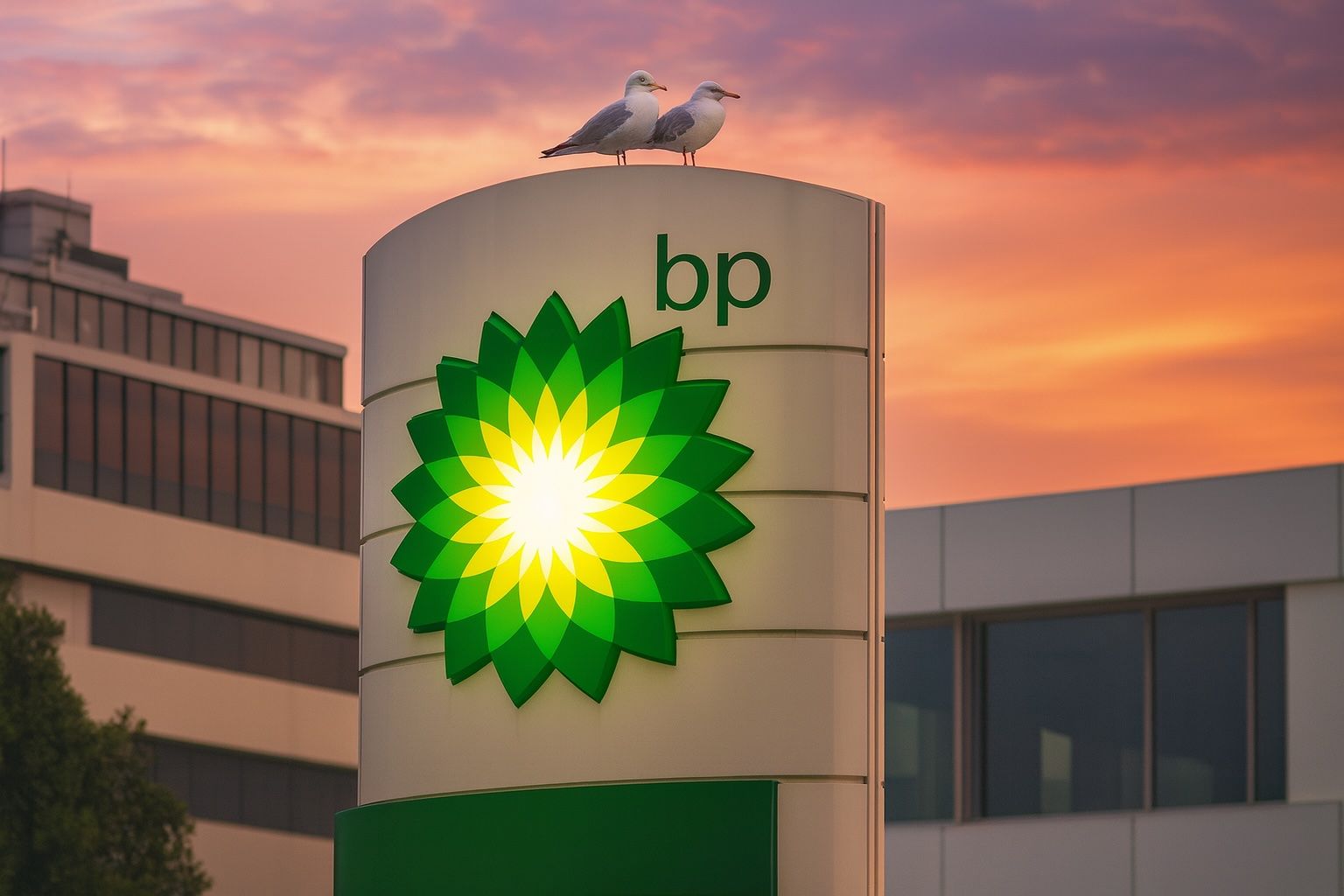Key Facts (as of Oct. 23, 2025):
- BP shares climb: BP’s stock rose on October 23, trading around 431.8 pence in London by midday (up from a 421.4p prior close) [1]. In New York, BP’s ADR last closed at $34.32 [2] after a strong overnight jump, reflecting renewed investor optimism.
- Oil price surge: Crude oil rallied sharply this week. Brent futures leapt nearly 5% to about $64.35/barrel after the U.S. imposed new sanctions on Russia’s largest oil companies (Lukoil and Rosneft) [3]. A surprise drop in U.S. crude inventories – stockpiles fell ~961,000 barrels vs an expected rise – underscored robust demand, further fueling the price spike [4].
- BP pivots back to oil: BP halted development of its U.S. Beacon offshore wind project, a 2.6 GW venture, citing soaring costs and unfavorable policy (President Trump’s opposition) [5]. The joint BP-JERA venture will lay off U.S. staff and “close operating activities” in the coming months. The move highlights BP’s strategic retreat from offshore wind to focus on higher-return oil & gas projects [6], aligning with management’s push to prioritize core hydrocarbon assets. BP is continuing aggressive share buybacks (3.75 million shares repurchased on Oct. 22 alone [7]) and recently greenlit a $5 billion Gulf of Mexico oil project [8] – reinforcing its commitment to traditional energy.
- Analysts see value: At current levels, BP trades at roughly 13× 2025 earnings with a 5.7% dividend yield, which some analysts call a “compelling value proposition” [9]. The average 12-month price target stands near 457.5 pence – about 10% above today’s price [10] – reflecting optimism that BP’s cash flow and buybacks can drive upside. Market consensus on the stock is mixed (mostly Hold ratings), but many experts note BP’s undervaluation relative to peers and its strong recent earnings.
- Outlook and risks: BP will report Q3 earnings on November 4, 2025 [11], with investors watching for guidance on dividends and buybacks amid the oil volatility. While the recent oil rebound is a tailwind, industry watchers warn that if crude retreats back to the mid-$50s (WTI hit ~$57 last week [12]), it could strain Big Oil’s shareholder payouts. Analysts caution that current dividend and buyback plans may be “unsustainable” if oil stays depressed [13] – BP already trimmed its buyback pace earlier this year to protect its balance sheet [14]. The company’s ability to navigate these cross-currents will shape its share price trajectory into 2026.
BP Share Price Jumps on Oil Rally
BP’s stock is getting a boost from a double-dose of positive momentum: a rallying oil market and company-specific strategic moves that investors are cheering. On October 23, BP’s London-listed shares traded around 431.8p, up roughly 2.5% from yesterday’s close [15]. In New York, BP’s American Depositary Shares mirrored the optimism – closing at $34.32 on Oct. 22 (a ~3.5% jump) [16] and poised for further gains if the momentum holds. These levels put BP stock near its highest in several weeks, though still below its 52-week peak (~471p) [17].
What’s driving the rebound? The primary catalyst is the surge in oil prices. Brent crude has climbed back above $64 per barrel, a notable rebound from the five-year lows seen earlier in the month [18] [19]. On Wednesday, the U.S. government announced sweeping sanctions on Russian oil giants Lukoil and Rosneft, aiming to cut off funding for Moscow’s war effort [20]. This geopolitical move immediately jolted energy markets – “Oil prices climbed after reports suggested the U.S. and India are close to finalising a deal to cut Russian crude imports,” noted MUFG analyst Soojin Kim, as traders anticipated tighter global supply [21]. By late Wednesday, Brent spiked ~5% (settling ~$3 higher on the day) to $64.35/bbl, while U.S. WTI crude jumped ~2.4% to ~$59.9/bbl [22].
Adding fuel to the oil rally, the latest U.S. data showed strong petroleum demand. The Energy Information Administration (EIA) reported an unexpected drawdown in crude inventories, signaling that refiners and drivers are gobbling up fuel faster than it’s being produced [23]. “We’ve got total oil demand above 20 million barrels per day – very impressive for shoulder season. It shows the demand side of the equation is robust,” said Phil Flynn, senior analyst at Price Futures Group [24]. Such robust consumption, even in the autumn lull, surprised many and helped push oil prices to their highest in nearly three weeks [25].
For oil-sensitive stocks like BP, rising crude prices directly bolster profit expectations. Higher Brent and WTI prices fatten the margins on each barrel BP produces, and they improve the outlook for the company’s giant trading division. It’s therefore no surprise that BP’s share price often moves in tandem with oil. “Oil’s rebound is putting some wind in the sails of energy stocks,” observed one market strategist, pointing out that integrated majors like BP are “quickly retracing losses from earlier in the month.” Just two weeks ago, sentiment was starkly different – on October 10, oil prices crumbled ~4% in a single day amid global recession fears and a surprise Israel-Hamas ceasefire that eased supply risks [26]. BP’s stock tumbled ~3% in London during that selloff [27], exemplifying how vulnerable it was to the oil slump and broader “risk-off” wave. Now, with crude recovering and geopolitical winds shifting, BP is bouncing back from that dip.
Market conditions have also improved beyond just oil. Global equities, though choppy, are stabilizing after the early-October shock. Hopes that President Trump will strike a trade truce with China – he’s set to meet President Xi Jinping next week – are helping calm some nerves [28]. For BP, which is a component of the UK’s FTSE 100 index, the broader market mood matters. The FTSE recently notched multi-year highs, and while BP has lagged the FTSE’s ~14% surge in 2025 (due in part to earlier oil weakness) [29], the stock is now catching up. In fact, BP’s U.S.-listed shares are up ~15% year-to-date [30] – slightly outperforming the S&P 500 – thanks to the tailwind from oil and a weaker British pound boosting the dollar-denominated ADR.
Strategic Shifts: Wind Project on Hold, Oil Investments Greenlit
Beyond the macro forces, BP’s own strategic decisions are playing a key role in its share price narrative. The company is doubling down on its oil-and-gas core business and tapping the brakes on some clean-energy projects that no longer make financial sense – and investors are applauding this pragmatism.
The latest example came this week: BP and its partner JERA are halting development of the Beacon offshore wind farm off New England. The joint venture, JERA Nex BP, announced it “did not see a viable path” forward for the 2.6 GW wind project under current conditions and will close its U.S. offshore wind operations, with all U.S. employees exiting in coming months [31] [32]. This is a major about-face for BP, which had entered U.S. offshore wind with fanfare a few years ago. Why the withdrawal? A perfect storm of economic and political headwinds: surging costs, supply chain disruptions, and an openly hostile stance toward offshore wind from the Trump administration. “The decision marks the latest setback for the U.S. offshore wind industry, which has been hit by soaring costs… and the impact of President Donald Trump’s opposition to such projects,” Reuters noted in its report [33]. Simply put, BP and JERA concluded there is “no viable path” for Beacon Wind in the current environment, so they’re pulling the plug.
Crucially, BP isn’t abandoning renewable energy altogether – but it is reasserting a more disciplined approach, focusing on profitability. The Beacon wind pause reflects a broader strategic pivot under CEO Murray Auchincloss (interim) and BP’s board: prioritizing high-return projects (oil & gas) and scaling back or delaying green projects that don’t yet pencil out. BP’s statement on the wind exit said the venture would retain its U.S. offshore lease rights and could resume development “at a more favourable time” [34], suggesting this may be a temporary retreat. Yet the message was clear: BP’s capital will be deployed where it earns the best returns for shareholders, which right now often means traditional energy.
In fact, BP’s recent actions have consistently tilted toward oil and gas expansion. Earlier this month, BP approved a $5 billion offshore drilling project in the Gulf of Mexico known as Tiber-Guadalupe [35] – one of its largest upstream investments in recent years. The project is expected to add substantial production in the late 2020s, highlighting BP’s confidence that oil demand will remain strong (a view reinforced by BP’s own forecast that global oil consumption will now peak only around 2030, later than previously thought [36]). The company has also been active on other fronts: per Reuters, BP’s new chairman Albert Manifold recently told employees the group needs to “move faster” in shifting focus from renewables to oil & gas and should consider selling certain assets to streamline operations [37]. And just a few weeks ago, BP quietly shelved plans for a large biofuels plant in Rotterdam – another project deemed uneconomic amid cost inflation [38]. Each of these steps, while disappointing to some environmental stakeholders, has been met with a nod of approval from the market, as they suggest BP will stick to its knitting (and its cash cows) during uncertain times.
Meanwhile, shareholder returns remain front and center. BP has been returning hefty sums of cash via buybacks and dividends, and it continues to do so. The company has an active share repurchase program – just on October 22, BP bought back 3.75 million shares on the London market [39] as part of an ongoing $1.5 billion buyback tranche. BP’s dividend, yielding around 5-6%, has also been growing modestly (the quarterly payout was hiked 4% earlier this year). By pulling back on some capital-intensive renewables and maintaining discipline on spending, BP aims to sustain these payouts even if oil prices wobble. “BP has already scaled back buybacks to shore up its debt-heavy balance sheet” when oil prices fell [40], notes TechStock², highlighting that management is willing to adjust capital returns to economic reality. That conservative stance – balancing investment in new projects with the need to keep debt in check and investors rewarded – appears to be restoring confidence in BP’s trajectory.
It’s a striking turnaround from a few years ago: under former CEO Bernard Looney, BP had trumpeted a pivot to “Energy Transition” businesses. But after Looney’s abrupt resignation in 2023, the company’s strategy evolved. Now, under interim leadership and a new chair, BP’s tone is more measured. Oil and gas aren’t being abandoned – they’re being leaned into, albeit with an eye on lower-carbon projects (like hydrogen and biofuels) at a pace that makes financial sense. This recalibrated strategy is essentially BP’s “back to basics” moment, and the stock’s recent resilience suggests investors believe it will drive stronger profits. As one analyst put it, “BP is essentially saying it will not chase low-margin renewables for the sake of optics. Cash flow comes first.” In the current market, that pragmatism is exactly what shareholders want to hear.
Energy Sector Trends: Volatile Oil Tests Nerves
BP’s fortunes don’t exist in a vacuum – they’re tied to the broader energy sector trends and global economic currents. So far in 2025, those currents have been volatile. The year began with oil in a comfortable range, but by this autumn, a combination of oversupply fears and macroeconomic headwinds drove oil into a steep downturn. In mid-October, U.S. oil prices plunged to levels not seen since 2021: WTI crude briefly traded under $57 per barrel [41] amid talk of a potential glut. The International Energy Agency projected an “unprecedented” 4 million barrels per day surplus by 2026 if producers kept pumping and demand growth stalled [42]. Major forecasters slashed their price outlooks – the U.S. EIA foresaw Brent averaging ~$62 in Q4 2025 and dropping to ~$52 in 2026 [43], while some banks warned a severe trade war could even send oil into the $40s [44].
These dour predictions coincided with real-time bearish shocks: high interest rates and slowing economies in the U.S., Europe, and China have sapped fuel demand growth. In early October, “rising trade tensions between the U.S. and China… weighed on oil prices,” noted UBS analyst Giovanni Staunovo, after Trump’s surprise tariff threats spooked traders [45]. At one point, the market was so grim that gasoline prices in the U.S. fell toward $3/gallon, relieving consumers but signaling economic worries [46].
For energy companies, especially European majors like BP, this posed a serious challenge. With Brent sliding into the low $60s and high $50s, profit margins were pinched. Analysts cautioned that if such prices persisted, Big Oil’s generous dividends and buybacks might not be sustainable [47]. In Europe, where BP, Shell, and TotalEnergies have been juggling transition investments and shareholder returns, weaker crude “is pressuring [their] finances,” as TechStock² reported [48]. BP proactively reacted by dialing down its share repurchases over the summer to avoid overstretching its balance sheet [49] – a prudent move that signaled to the market that the company would not compromise its financial health just to maintain cash returns. This belt-tightening is one reason BP’s gearing (debt ratio) has improved and why credit analysts remain comfortable with the company’s dividend policy for now.
However, the landscape has shifted yet again in the past few days, reminding everyone how quickly sentiment can turn. The late-October oil price resurgence – spurred by geopolitical actions (U.S. sanctions on Russia) and surprisingly strong demand – has given oil executives and investors a reprieve from the doom-and-gloom scenarios. Brent back in the mid-$60s is a far cry from $50, and if prices hold here or rise further, cash flows for companies like BP will swell accordingly. It’s worth noting that OPEC+ has also indicated a more cautious approach going forward; earlier fears of the group ramping up supply indiscriminately have eased. In fact, reports (including a Reuters leak) suggest OPEC and its allies may extend output cuts or at least avoid flooding the market [50] to support prices, especially with global inventories still high.
Another trend benefiting BP: the resilience of energy stocks even during oil’s weakest moments. In mid-October, as oil bottomed out, North American oil equities largely held their ground (helped by factors like Buffett’s backing of Occidental Petroleum) [51]. BP’s UK shares did slip during the worst of the oil drop, but compared to the freefall in crude, the equity reaction was muted – a sign that investors saw the low prices as likely temporary. Now, as oil rebounds, energy stocks are quickly gaining. This asymmetric reaction (limited downside, full upside) often occurs when stocks already price in a lot of bad news. It suggests that investors believe oil will not “stay low forever” – a thesis BP’s management also seems to share, given its continued investment in long-term oil projects.
One wildcard for the sector is politics and policy. The contrast between the U.S. and Europe is stark: President Trump’s policies have tilted firmly toward fossil fuels (e.g. encouraging drilling, opposing wind projects), whereas Europe still pushes climate goals. BP finds itself navigating this dual reality – leaning into U.S. oil opportunities on one hand, while facing pressure to uphold ESG commitments on the other (particularly in its home UK/EU market). How BP balances these will remain a key narrative. Notably, BP’s new strategy is being closely watched by policymakers and activists. Thus far, the company maintains it’s still committed to net-zero 2050 goals, but with a “more balanced” approach. The market, at least, seems comfortable with BP’s current calibration between profit and planet.
Analyst Commentary and Market Outlook
Looking ahead, what’s next for BP’s share price? Much will depend on external variables like oil prices and economic conditions, but also on BP’s own execution in the coming quarters. Here are a few perspectives from experts:
- Wall Street consensus: BP’s stock has a consensus “Hold” rating and a fairly moderate upside forecast. According to MarketBeat, the average 12-month price target is about 457.5 pence for the London shares [52]. That’s roughly 10% above the latest price – a notable but not sky-high gain – reflecting cautious optimism. The highest analyst target is 500p and the lowest around 420p [53], indicating some disagreement on BP’s trajectory. Only 1 out of 4 analysts recently covering the stock has a Buy on it [54], with the rest at Hold, which underscores the “wait-and-see” sentiment. Many analysts are essentially saying: BP is solid and undervalued, but they want to see more evidence of sustained oil price strength or strategic delivery before turning outright bullish.
- Undervalued or value trap? Bulls argue that BP offers considerable value at current levels. “BP remains undervalued, trading at just ~13 times 2025 earnings, with a 5.7% dividend yield, offering a compelling value proposition,” one Seeking Alpha analysis noted [55]. By comparison, the broader market trades at much higher multiples with lower yields. Proponents highlight BP’s strong Q2 results and cash flow, operational efficiencies, and its shift toward “disciplined growth” in oil & gas as reasons the stock could re-rate higher [56]. Some also point out that BP’s book value and asset base (including valuable oil reserves) justify a higher share price if commodity prices cooperate. In short, from a fundamental standpoint, BP looks cheap – if it can avoid major missteps.
- Dividend durability: Income-focused investors are keenly watching BP’s dividend, which currently yields around 5-6% annually. That is well above the market average, but is it safe? BP’s management has raised the dividend modestly and is committed to annual increases of 4% through 2025, plus buybacks, as part of its investor proposition. The payout ratio is reasonable, and at $60+ oil the dividend is well covered by earnings and cash flow. However, analysts warn that if oil were to slump and stay low (say in the $50-55 range for a year), BP might face tough choices. A recent analysis by TechStock² cautioned that current payout plans could become “unsustainable” in a prolonged low-price scenario [57]. Investors still vividly remember 2020, when BP halved its dividend amid the Covid crash. The company is in a much stronger position now, but the lesson remains: oil volatility can quickly change the calculus. For the moment, though, BP’s dividend looks secure and quite attractive – and it’s a key reason many shareholders stick with the stock.
- Upcoming catalysts: The next big event on BP’s calendar is its third-quarter earnings release on November 4, 2025 [58]. This report will give a detailed look at how BP performed over the summer quarter, including perhaps some early figures on Q4 so far. Analysts expect solid results given that oil and gas prices, while choppy, averaged in a decent range during Q3. Key metrics to watch will be BP’s cash flow and net debt (indicating how much room there is for buybacks), refining margins (which have been relatively strong globally), and any updates to capital expenditure plans for low-carbon projects versus oil projects. The earnings call could also provide guidance on how BP sees 2026 shaping up. Notably, BP’s peers like Shell, Exxon, and Chevron will also report around this time; any industry-wide trends (e.g. cost inflation, demand outlooks, surprises in trading profits) will likely rub off on BP’s stock as well.
- Market wildcards: Beyond earnings, broader factors will influence BP. Geopolitics is front and center – the outcome of U.S.–China trade negotiations, further sanctions on oil producers (Russia, Iran), and OPEC+ policy decisions could all swing oil prices and energy equities. Likewise, macroeconomic signals (interest rates, recession odds) continue to affect investor appetite for cyclical stocks like oil companies. One encouraging sign is that energy equities have recently shown resilience even when other sectors falter, as investors view oil stocks as underpriced and offering good yield. If global markets stay volatile, BP might actually benefit from some rotation into “value” sectors. Conversely, any major drop in oil demand (for example, from a significant economic downturn) would pose a risk to BP’s recovery.
Bottom line: BP’s share price on October 23 reflects a cautiously optimistic story – one of recovery and realignment. The stock is regaining lost ground thanks to a combination of external uplift (the oil rally) and internal strategy moves (focusing on profitable projects and shareholder returns). In the near term, if oil prices remain supported in the $60+ range and BP delivers a confident earnings message in early November, analysts say the stock could extend its gains. Some are eyeing the 450–480p range as a potential next stop, which would bring BP closer to its post-pandemic highs [59]. Longer-term, the jury is out on how well BP can balance its energy transition ambitions with the need for profit. The company’s recent actions suggest a more conservative, returns-driven path that the market clearly appreciates for now. As one industry expert summed up: “BP has got its mojo back by going back to basics – pumping oil, cutting costs, and paying investors. So long as they keep at it and oil doesn’t collapse again, the share price has room to run.”
Sources: Recent market data and analyst commentary from Investing.com [60] [61]; oil market developments reported by Reuters [62] [63] and OilPrice.com [64]; BP corporate moves via Reuters [65] [66] and TS2.tech [67]; valuation insights from Seeking Alpha/MarketBeat [68] [69]; energy sector trends from TS2.tech (TechStock²) [70] [71] and Reuters.
References
1. www.investing.com, 2. www.investing.com, 3. www.reuters.com, 4. www.reuters.com, 5. www.reuters.com, 6. www.reuters.com, 7. www.tradingview.com, 8. stockanalysis.com, 9. stockanalysis.com, 10. www.marketbeat.com, 11. www.investing.com, 12. ts2.tech, 13. ts2.tech, 14. ts2.tech, 15. www.investing.com, 16. www.investing.com, 17. www.investing.com, 18. ts2.tech, 19. ts2.tech, 20. www.reuters.com, 21. www.reuters.com, 22. www.reuters.com, 23. www.reuters.com, 24. www.reuters.com, 25. oilprice.com, 26. ts2.tech, 27. ts2.tech, 28. www.reuters.com, 29. www.fool.co.uk, 30. stockanalysis.com, 31. www.reuters.com, 32. oilprice.com, 33. www.reuters.com, 34. www.reuters.com, 35. stockanalysis.com, 36. stockanalysis.com, 37. stockanalysis.com, 38. stockanalysis.com, 39. www.tradingview.com, 40. ts2.tech, 41. ts2.tech, 42. ts2.tech, 43. ts2.tech, 44. ts2.tech, 45. ts2.tech, 46. ts2.tech, 47. ts2.tech, 48. ts2.tech, 49. ts2.tech, 50. oilprice.com, 51. ts2.tech, 52. www.marketbeat.com, 53. www.marketbeat.com, 54. www.marketbeat.com, 55. stockanalysis.com, 56. stockanalysis.com, 57. ts2.tech, 58. www.investing.com, 59. www.marketbeat.com, 60. www.investing.com, 61. www.investing.com, 62. www.reuters.com, 63. www.reuters.com, 64. oilprice.com, 65. www.reuters.com, 66. www.reuters.com, 67. ts2.tech, 68. stockanalysis.com, 69. www.marketbeat.com, 70. ts2.tech, 71. ts2.tech







